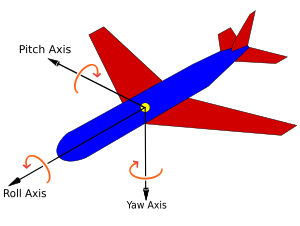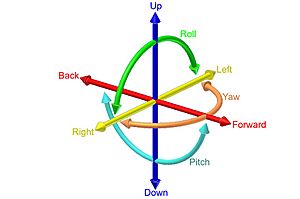Pitch, yaw, and roll facts for kids

Imagine you're flying a plane, swimming like a fish, or even controlling a spacecraft! How do these objects move and turn in the air or water? They use three main types of movement called pitch, yaw, and roll. These terms help us understand how things move and change direction in three dimensions.
Contents
Understanding Pitch, Yaw, and Roll
Pitch, yaw, and roll are like the ABCs of movement for objects that travel through air, water, or space. They describe how an object can tilt, turn, or spin. Think of an airplane flying, a fish swimming, or a spacecraft exploring the stars. All of them use these movements to control where they go and how they are positioned.
The Three Main Movements
Let's break down each of these important movements. They are all independent, meaning one movement doesn't automatically cause another.
Pitch: Nose Up or Down
Pitch is when an object's nose or front end moves up or down. Imagine an airplane. When it pitches up, its nose points towards the sky, and it starts to climb. When it pitches down, its nose points towards the ground, and it starts to dive. This movement happens around an imaginary line that goes from one wingtip to the other.
Yaw: Side-to-Side Movement
Yaw is when an object's nose moves from side to side, like shaking your head "no." For an airplane, if it yaws to the left, its nose points left, and the plane turns left. If it yaws to the right, its nose points right, and the plane turns right. This movement happens around an imaginary line that goes straight up and down through the middle of the object.
Roll: Spinning Around
Roll is a circular movement where the object spins around its long axis. Think of a plane doing a barrel roll. One wing goes down while the other goes up. This movement happens around an imaginary line that goes from the nose to the tail of the object. It's like the object is rotating along its own length.
Six Degrees of Freedom
While we focus on pitch, yaw, and roll for rotations, objects can also move in three other ways:
- Forward and backward
- Up and down
- Left and right
When you combine these three straight-line movements with the three rotational movements (pitch, yaw, and roll), you get a total of six independent ways an object can move in 3D space. This is called having "six degrees of freedom." Each of these movements can happen on its own, which gives pilots, submarine captains, and spacecraft engineers a lot of control!
How Objects Control Movement
Objects like airplanes, submarines, and fish use special parts to control their pitch, yaw, and roll.
- Airplanes have movable surfaces on their wings and tail, like ailerons, elevators, and rudders. These surfaces change how air flows over them, allowing the pilot to control the plane's attitude.
- Fish use their fins in a similar way. Their fins help them steer, dive, climb, and turn in the water.
- Submarines also have fins and rudders to help them move through water and change their depth and direction.
Understanding pitch, yaw, and roll is key to designing and controlling anything that moves through a fluid, whether it's air or water, or even the vacuum of space!


